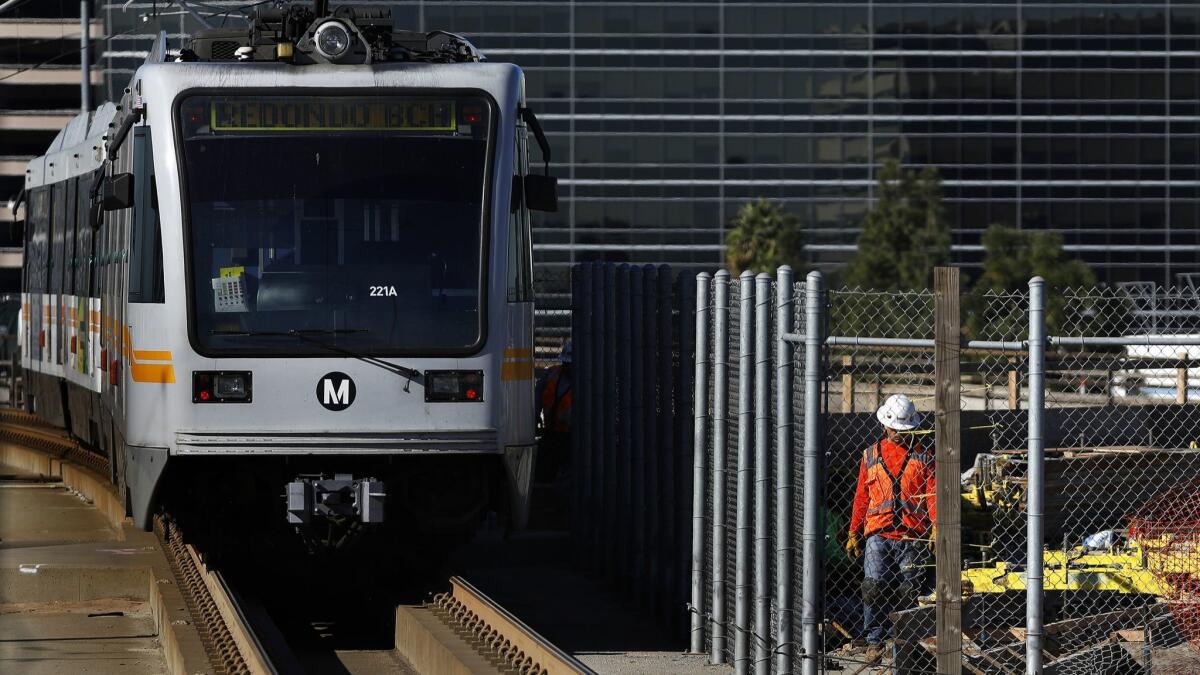Metro backs temporary plan to preserve Green Line service for South Bay riders

Los Angeles County transportation leaders faced a politically tricky decision Thursday in how to connect two light rail lines: They could back a plan favorable to South Bay riders, or one preferred by Los Angeles officials.
In the end, the South Bay prevailed — if only temporarily.
Directors with the Metropolitan Transportation Authority voted 7 to 4 to support a plan that would allow South Bay commuters to travel most of the Green Line without changing trains. But the victory for South Bay riders could limit the capacity on the Crenshaw Line, which will be restricted to two-car trains for a year after it opens.
The Metro board also narrowly rejected an attempt by Los Angeles Mayor Eric Garcetti to delay a decision on the issue until February.
Los Angeles County Supervisor Janice Hahn, who represents the South Bay, said the plan was a compromise that would “serve our riders in the best way possible.”
When Metro designed the Crenshaw Line, engineers included a junction in El Segundo that will allow trains to run seamlessly onto the Green Line tracks, creating a one-seat, 22-mile ride between L.A.’s Mid-City neighborhood and Norwalk.
But the design has exposed some limitations in Metro’s rail system, including issues at some stations along the Green Line that prevent the frequent operation of three-car trains.
Running two-car and three-car trains along the Green Line tracks could lead to electrical problems, limiting trains’ acceleration or even shutting down the operation of the line, officials said.
“It’s a high-wire act without a safety net,” said James Gallagher, Metro’s chief operations officer. Service, he said, could “certainly be spotty.”
Under Thursday’s decision, the Crenshaw Line will be restricted to two-car trains. Councilman Mike Bonin, who represents West L.A., said the South Bay’s plan would send the message to South Los Angeles that “we’re only giving you two-thirds of what we could give you.”
Metro staff members had proposed to address the capacity issues on the Green Line by breaking the line into two pieces at Aviation Boulevard, restricting the portion of the line along the 105 to three-car trains that would connect from the Crenshaw Line.
Riders at the South Bay’s four stations would have been forced to change trains at Aviation, adding seven minutes to a one-way trip for about 12% of riders.
“The opening of the Crenshaw Line should yield more service throughout the system, not less,” said Don Szerlip, a Redondo Beach resident and the vice-chair of Metro’s South Bay service council. The design would force “a minimum of two transfers” to reach downtown, which would drive riders away, he said.
Metro officials said that adding more capacity along the corridor between the Mid-City area and Norwalk would help build regional transit ridership, including among workers headed into the area around Los Angeles International Airport.
The South Bay’s plan would require riders coming from Redondo Beach to change trains to reach the future rail connection to LAX at 96th Street and Aviation Boulevard, which is slated to open in 2023.
Several speakers urged Metro’s plan, saying it would benefit the region to serve LAX from all three directions, particularly as the Southland looks toward extending the Green Line to Torrance and the Crenshaw Line into Hollywood and West Hollywood.
“We see this as a long-term vision that stretches from Torrance … all the way to Wilshire Boulevard, to Hollywood and West Hollywood,” said Jerard Wright, the policy director at the Los Angeles County Business Federation.
The Crenshaw Line is slated to open in mid-2020. The service plan will be reevaluated in 2021, two years before the airport station opens, officials said.
For more transportation news, follow @laura_nelson on Twitter.
More to Read
Sign up for Essential California
The most important California stories and recommendations in your inbox every morning.
You may occasionally receive promotional content from the Los Angeles Times.











